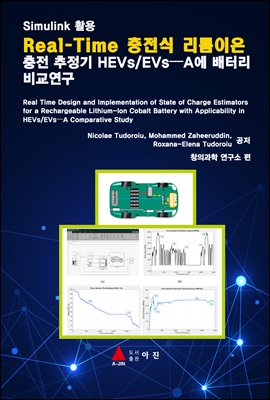
Real Time 충전식 리튬이온 충전 추정기 HEVs/EVs-A에 배터리 비교연구
- 저자Nicolae Tudoroiu, Mohammed Zaheeruddin, Roxana-Elena Tudoroiu 저
- 출판사아진
- 출판일2020-07-13
- 등록일2020-12-21
- SNS공유


- 파일포맷PDF
- 파일크기22MB
- 공급사YES24
-
지원기기
PC
PHONE
TABLET
프로그램 수동설치
전자책 프로그램 수동설치 안내
아이폰, 아이패드, 안드로이드폰, 태블릿,
보유 1, 대출 0,
예약 0, 누적대출 8, 누적예약 0
책소개
Estimating the state of charge (SOC) of Li-ion batteries is an essential task ofbattery management systems for hybrid and electric vehicles. Encouraged by some
preliminary results from the control systems field, the goal of this work is to
design and implement in a friendly real-time MATLAB simulation environment two
Li-ion battery SOC estimators, using as a case study a rechargeable battery of 5.4
Ah cobalt lithium-ion type. The choice of cobalt Li-ion battery model is motivated
by its promising potential for future developments in the HEV/EVs applications.
The model validation is performed using the software package ADVISOR 3.2,
widely spread in the automotive industry. Rigorous performance analysis of both
SOC estimators is done in terms of speed convergence, estimation accuracy and
robustness, based on the MATLAB simulation results. The particularity of this
research work is given by the results of its comprehensive and exciting
comparative study that successfully achieves all the goals proposed by the research
objectives. In this scientific research study, a practical MATLAB/Simscape battery
model is adopted and validated based on the results obtained from three different
driving cycles tests and is in accordance with the required specifications. In the
new modelling version, it is a simple and accurate model, easy to implement in
real-time and offers beneficial support for the design and MATLAB implementation
of both SOC estimators. Also, the adaptive extended Kalman filter SOC estimation
performance is excellent and comparable to those presented in the
state-of-the-art SOC estimation methods analysis.
목차
제 1편 : SIMULINK 기본편1.1 SIMULINK의 시작 1
블록의 연결 5
블록 파라미터의 설정 7
시뮬레이션 파라미터 (Configuration Parameters)의 설정 8
시뮬레이션의 수행 9
블록 파라미터의 표시 9
복수 데이터의 표시 11
2.2 동적 시뮬레이션 13
이차 미분방정식 17
선형 상태변수 모델 23
DC 모터의 시뮬레이션 24
함수 블록의 사용 29
차분방정식(difference equation)의 모델링 34
Subsystem(부시스템)의 구성 37
제 2편 : 연구논문
1. Introduction 41
2. Lithium-Ion Battery-Cell Modelling and Validation 42
3. FDDI estimation techniques. 44
4. Li-Ion Co Battery State of Charge Estimation Algorithms 61
5. Real-Time MATLAB Simulation Results 66
6. Discussions 77
7. Conclusions 79
8. References 85

















